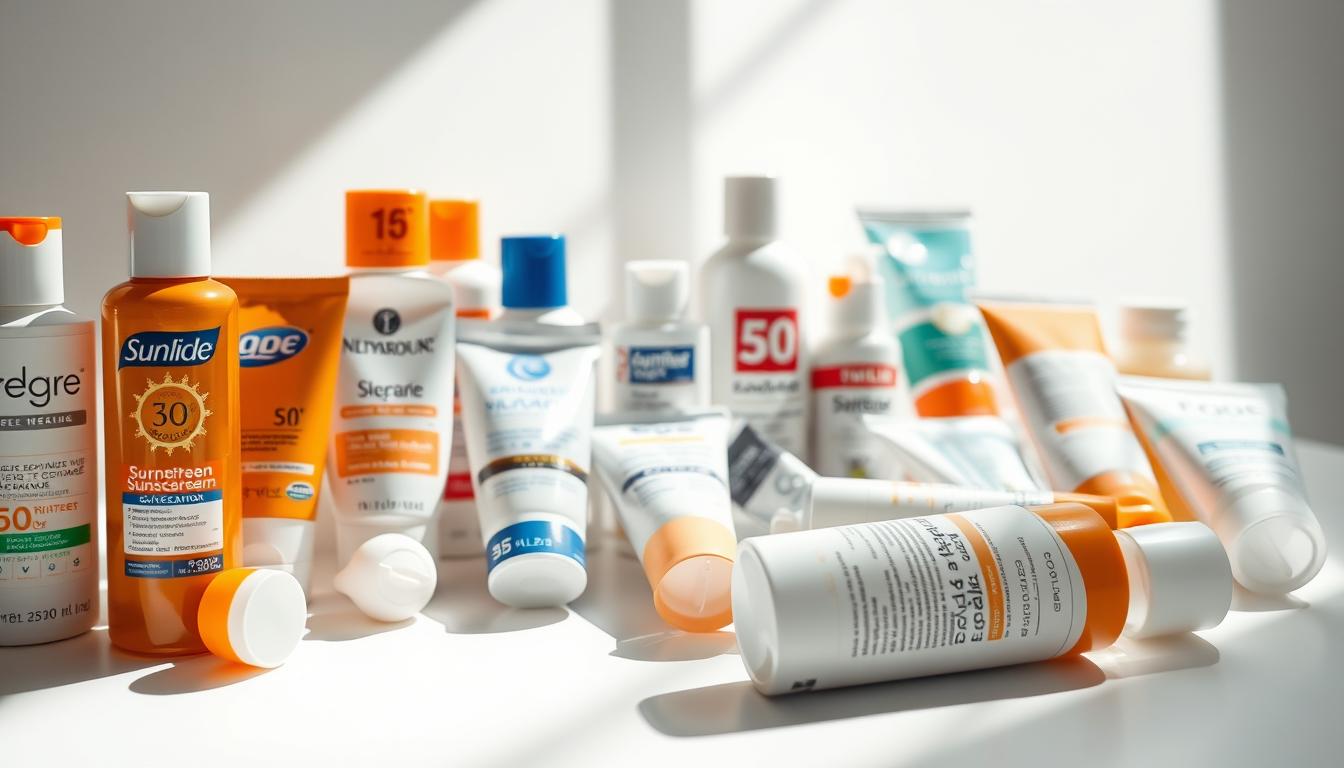
With the increasing awareness of skin damage caused by UV rays, choosing the right sunscreen has become crucial for Australians who spend a lot of time outdoors.
The Choice sunscreen test has evaluated various sunscreens to help consumers make informed decisions. This article provides an overview of the best sunscreens available, focusing on their SPF levels and sun protection capabilities.
Understanding the importance of sun protection is vital for preventing skin damage and reducing the risk of skin cancer. This guide will walk you through the key findings of the Choice sunscreen test, helping you select the most effective sunscreen for your needs.
Key Takeaways
- Top-rated sunscreens that passed the Choice sunscreen test
- Understanding SPF and its significance in sun protection
- How to choose the best sunscreen for your skin type
- The importance of broad-spectrum protection
- Tips for applying sunscreen effectively
Why Sun Protection Matters in Australia
The importance of sun protection in Australia cannot be overstated due to the country’s extreme UV levels. Australia’s geographical location and clear skies make it one of the sunniest countries in the world, posing significant health risks to its population.
Australia’s High UV Exposure Risks
Australia experiences some of the highest UV radiation levels globally, with UV indexes often exceeding 12 during peak summer months. This extreme exposure significantly increases the risk of skin damage, including sunburn and long-term skin issues.
Skin Cancer Statistics in Australia
Australia has one of the highest rates of skin cancer in the world, with more than 2 in 3 Australians developing some form of skin cancer by the age of 70. As stated by the Australian Government’s Cancer Council, “Skin cancer is the most common cancer in Australia, and it’s largely preventable.”
“Skin cancer is the most common cancer in Australia, and it’s largely preventable.”
Beyond Sunburn: Long-term Skin Damage
While sunburn is an immediate concern, prolonged UV exposure also leads to long-term skin damage, including premature aging and increased risk of melanoma. Effective sun protection is crucial in mitigating these risks and ensuring long-term skin health.
Understanding the risks associated with UV exposure is the first step in protecting your skin. By being aware of the potential dangers and taking proactive measures, Australians can significantly reduce their risk of skin-related issues.
Understanding the Choice Sunscreen Test
The Choice sunscreen test is a comprehensive evaluation of various sunscreens available in the Australian market. This test is crucial for consumers who want to make informed decisions about their sun protection.
How Choice Conducts Sunscreen Testing
Choice conducts its sunscreen testing using rigorous methods to ensure accurate and reliable results. The testing process involves evaluating sunscreens based on several key parameters, including SPF, water resistance, and UVA protection.
The testing is carried out in a controlled environment to simulate real-world conditions. This ensures that the results are relevant and applicable to everyday use.
Testing Parameters and Evaluation Criteria
The testing parameters for the Choice sunscreen test include:
- SPF rating and its effectiveness in blocking UVB rays
- UVA protection and its importance for preventing skin damage
- Water resistance and its relevance for individuals who engage in water activities
These parameters are evaluated against established standards to determine the overall performance of each sunscreen.
Why Independent Testing Matters
Independent testing, such as that conducted by Choice, is essential for providing unbiased and reliable information. It helps consumers make informed decisions by comparing the performance of different sunscreens.
Independent testing matters because it ensures that manufacturers’ claims do not influence the results. This provides consumers with confidence in the products they choose.
How to Interpret Sunscreen Test Results
Understanding the results of sunscreen tests can be daunting, but it’s crucial for making informed decisions about sun protection. The Choice sunscreen test evaluates various aspects of sunscreens, including their SPF ratings, UVA and UVB protection, water resistance, and overall performance relative to their price.
Decoding SPF Ratings and What They Mean
The Sun Protection Factor (SPF) is a measure of how well a sunscreen protects against ultraviolet B (UVB) rays, which are a primary cause of sunburn. SPF is not a direct measure of protection time but rather a measure of the amount of UVB radiation required to produce sunburn on protected skin. For example, SPF 30 means that it would take 30 times longer for the skin to redden than if no sunscreen were applied. However, the actual protection duration depends on several factors, including skin type, amount applied, and activities like swimming or sweating.
“The SPF rating is not a measure of how long you can stay in the sun, but rather how well the sunscreen protects against UVB rays.”
UVA vs UVB Protection Measurements
While SPF measures protection against UVB rays, UVA protection is equally important as UVA rays penetrate deeper into the skin, causing aging and potentially skin cancer. UVA protection is often measured using the ‘UVA rating’ or ‘UVA protection factor’. The Choice sunscreen test evaluates both UVA and UVB protection to give a comprehensive view of a product’s overall protective capabilities.
Water Resistance Claims and Testing
For individuals who plan to be in the water or sweat heavily, water resistance is a critical factor. The Choice test assesses water resistance by evaluating how well sunscreens maintain their SPF level after being submerged in water. It’s essential to understand that ‘water-resistant’ does not mean ‘waterproof’; reapplication is still necessary after swimming or sweating.
- Check the label for water resistance claims.
- Understand that water resistance is tested for a specific duration.
- Reapply sunscreen after swimming or sweating.
Price vs Performance Analysis
The price of sunscreen can vary significantly, but does a higher price always mean better performance? The Choice test compares the performance of sunscreens across different price points to help consumers identify the best value for their money. Some affordable options may offer comparable protection to more expensive brands.
By understanding these aspects of sunscreen test results, consumers can make more informed decisions about their sun protection, balancing factors like protection level, water resistance, and price.
Top-Performing Sunscreens in the Latest Choice Sunscreen Test
The latest Choice sunscreen test has revealed the top-performing sunscreens that Australians can trust for effective sun protection. This comprehensive test evaluated various sunscreen products based on their SPF ratings, UVA and UVB protection, water resistance, and overall value for money.
Best Overall Sunscreens
The best overall sunscreens delivered exceptional performance across all testing parameters. These products stood out for their ability to provide broad-spectrum protection and durability.
Lotion Formulations
Lotion formulations were among the top performers, offering excellent skin protection and moisturizing benefits. Brand X’s SPF 50 lotion was a standout, providing robust protection without feeling greasy.
Spray Options
Spray sunscreens also performed well, particularly for their ease of application and quick absorption. Brand Y’s SPF 50 spray was praised for its convenience and effectiveness, making it ideal for active users.
Best Value for Money Options
For consumers on a budget, several sunscreens offered excellent value for money without compromising on performance. Brand Z’s SPF 30 lotion was highlighted as a cost-effective option that still delivered on protection and quality.
Underperforming Products to Avoid
Not all sunscreens tested performed satisfactorily. Products that failed to meet expectations included Brand A’s SPF 50 spray, which did not provide adequate UVA protection, and Brand B’s SPF 30 lotion, which was overly greasy and slow to absorb.
How to Select the Right Sunscreen Type for Your Needs
To ensure you’re protected, it’s crucial to choose a sunscreen that aligns with your lifestyle and skin type. With numerous options available, selecting the right one can be overwhelming. However, by breaking down the process into manageable steps, you can find the perfect sunscreen for your needs.
Step1: Identify Your Skin Type
Understanding your skin type is the first step in choosing the right sunscreen. If you have sensitive skin, look for products labeled “hypoallergenic” or “fragrance-free” to minimize irritation risks. For oily skin, opt for lightweight, oil-free formulations that won’t clog pores.
Step2: Consider Your Activities and Exposure Level
Your daily activities play a significant role in determining the type of sunscreen you need. If you’re involved in outdoor activities or sports, you’ll require a water-resistant sunscreen that can withstand sweat and water exposure. For everyday use, a standard sunscreen with appropriate SPF should suffice.
Step3: Choose Between Chemical and Physical Formulations
Sunscreens come in two main types: chemical and physical. Chemical sunscreens absorb UV rays, while physical sunscreens (zinc oxide, titanium dioxide) create a barrier on the skin’s surface. Chemical sunscreens are often more cosmetically elegant, but physical sunscreens provide immediate protection and are generally considered safer for coral reefs.
“The choice between chemical and physical sunscreens depends on your skin type, activities, and personal preferences.”
Step4: Evaluate Additional Features and Benefits
Some sunscreens offer additional benefits such as moisturizing properties, anti-aging ingredients, or bug repellents. Consider what extra features are important to you and choose a sunscreen that meets these needs. For example, if you have dry skin, a moisturizing sunscreen can provide hydration while protecting against UV rays.
By following these steps, you can select a sunscreen that not only protects your skin from the sun but also complements your lifestyle. Remember, the best sunscreen is one that you will use consistently and correctly.
Proper Sunscreen Application Guide
Understanding how to apply sunscreen correctly can significantly enhance its protective capabilities. Proper application ensures that you get the full SPF benefit and adequate protection against UVA and UVB rays.
Step1: Determining the Correct Amount
To apply sunscreen effectively, you need to use the right amount. The general rule of thumb is to use about one ounce (a shot glass full) for the entire body.
The Teaspoon Rule
For adults, using about two teaspoons for the face, neck, and ears, and one teaspoon for each limb is recommended.
Coverage Maps for Different Body Areas
Visual guides can help determine the correct coverage for different body parts, ensuring no area is left unprotected.
Step2: Application Timing and Technique
Apply sunscreen 15-30 minutes before going outdoors. Use a generous amount and rub it in thoroughly to avoid any greasy residue.
Step3: Reapplication Schedule and Methods
Reapply sunscreen every two hours or immediately after swimming or sweating. Using a lip balm with SPF and applying it frequently can also protect your lips.
Common Application Mistakes to Avoid
Common mistakes include applying too little sunscreen, not reapplying often enough, and missing critical areas like the tops of ears and the back of the neck.
Key Takeaways:
- Use enough sunscreen to cover all exposed skin.
- Apply sunscreen before going outside.
- Reapply regularly.
Sunscreen for Special Needs and Conditions
Understanding the right sunscreen for special needs is crucial for effective sun protection. Different individuals have unique requirements based on their skin type, age, and activities.
Children and Infants
For children and infants, it’s essential to choose a sunscreen that is gentle on their skin yet effective against UV rays. Look for products labeled as “suitable for children” or “pediatrician-approved.” Sunscreens with zinc oxide or titanium dioxide are often recommended as they provide broad-spectrum protection and are less likely to cause skin irritation.
Sensitive or Acne-Prone Skin
Individuals with sensitive or acne-prone skin should opt for sunscreens that are labeled “non-comedogenic” or “hypoallergenic.” These products are designed to minimize the risk of allergic reactions and are less likely to clog pores. Fragrance-free sunscreens can also be a good option to reduce irritation.
Outdoor Sports and Water Activities
For those engaging in outdoor sports and water activities, water-resistant sunscreens are a must. These products are designed to stay on the skin longer, even when sweating or swimming. Look for sunscreens with a high SPF rating and those that offer broad-spectrum protection to ensure comprehensive coverage against both UVA and UVB rays.
By choosing the right sunscreen for your specific needs, you can enjoy the outdoors while protecting your skin from the harmful effects of the sun.
Understanding Sunscreen Labels and Ingredients
Understanding what’s in your sunscreen and what the labels mean is key to effective sun protection. In Australia, where UV exposure is a significant concern, being informed about sunscreen ingredients and regulatory standards can help you make the best choices for your skin.
Australian Regulatory Standards and Requirements
Australia has strict regulations regarding sunscreen labeling and ingredients. The Therapeutic Goods Administration (TGA) oversees the industry, ensuring that products meet certain standards for safety and efficacy. Sunscreen labels must include information about SPF ratings, water resistance, and UVA protection, giving consumers a clear understanding of what they’re getting.
Key Ingredients to Look For
When choosing a sunscreen, look for ingredients that provide broad-spectrum protection. Zinc oxide and titanium dioxide are physical sunblocks that sit on the skin’s surface, reflecting UV rays. Chemical active ingredients like avobenzone and octocrylene absorb UV radiation, converting it into heat that’s released from the skin. Understanding these ingredients can help you select a product that suits your skin type and needs.
Potentially Problematic Ingredients
Some sunscreen ingredients have raised health and environmental concerns. For instance, oxybenzone and octinoxate have been linked to coral reef damage, leading some regions to ban their use. Being aware of these issues can help you make more environmentally friendly and safe choices for your skin.
Environmentally Responsible Sunscreen Choices
The shift towards environmentally responsible sunscreen choices is gaining momentum in Australia, driven by consumer demand for sustainable products. As consumers become more aware of the environmental impact of their purchasing decisions, the demand for eco-friendly sunscreens has increased significantly.
Reef-Safe Formulations for Ocean Activities
One of the critical aspects of environmentally responsible sunscreens is their impact on coral reefs. Certain chemicals found in some sunscreens, such as oxybenzone and octinoxate, have been shown to harm coral reefs. Reef-safe formulations that avoid these chemicals are becoming increasingly popular among consumers who enjoy ocean activities. When choosing a sunscreen for water activities, look for products labeled as “reef-safe” to help protect Australia’s beautiful coral reefs.
Sustainable Packaging Options
Apart from the formulation, the packaging of sunscreens also has a significant environmental impact. Sustainable packaging options, such as recyclable materials, biodegradable packaging, or minimal packaging designs, can significantly reduce waste. Consumers can contribute to reducing plastic waste by opting for sunscreens with eco-friendly packaging.
Cruelty-Free and Vegan Certifications
For many consumers, the ethical implications of their sunscreen choices are just as important as the environmental impact. Cruelty-free certifications ensure that the products have not been tested on animals, while vegan certifications guarantee that no animal-derived ingredients are used. Choosing sunscreens with these certifications aligns with a lifestyle that values animal welfare and environmental sustainability.
By considering these factors and choosing reef-safe sunscreens, have sustainable packaging, and carry cruelty-free and vegan certifications, Australians can enjoy the sun while protecting both their skin and the environment.
Conclusion: Making Informed Sunscreen Decisions
Choosing the right sunscreen can be a daunting task, but with the insights from the Choice sunscreen test, Australians can make informed decisions to protect their skin from the harsh sun.
By understanding the testing parameters, SPF ratings, and UVA vs UVB protection measurements, individuals can select a sunscreen that meets their specific needs, whether it’s for everyday use, outdoor sports, or water activities.
When making sunscreen choices, consider factors such as skin type, activity level, and environmental impact. Opt for reef-safe formulations and sustainable packaging to minimize harm to the environment.
Ultimately, making informed decisions about sunscreen choices is crucial for effective sun protection. By being aware of the key ingredients, regulatory standards, and potential allergens, Australians can enjoy the outdoors while safeguarding their skin health.



